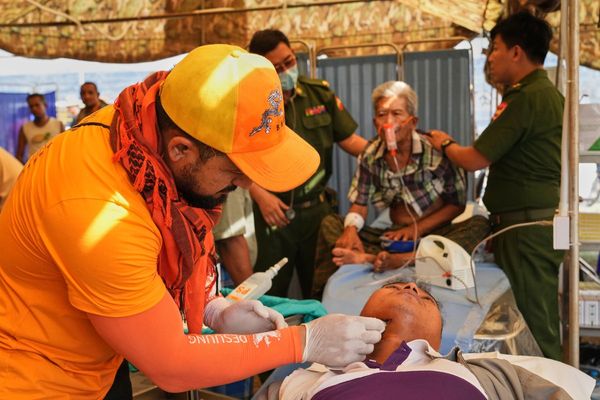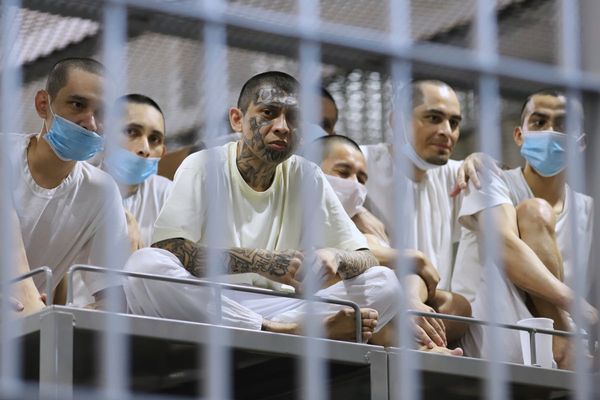
I can’t say these are the greatest short films of all time: there are thousands and thousands of short films and you’d have to watch all of them. Most of them I saw when I was making short films, going to film festivals and watching a lot of them. These are the films that have stayed with me. They are films that I thought I’d like to share with the world, that more people should see them. In no particular order, here they are.
The Cat With Hands (2001)
Grimm-style fairytale from director Rob Morgan about a gruesome mutant cat-human hybrid being.
This feels like a story that has existed for hundreds of years and yet the director was actually inspired by a dream that his sister had. I just love the fact that it’s a recently invented fairytale. It’s three and a half minutes long and is so perfectly told: that’s something you are always striving for in short films, to find a complete story, and so many shorts don’t manage that. It’s such an incredibly nightmarish film; weird and riveting in its fusion of animation and live action to craft a strange fairytale world – and the buildup and mad editing of the finale is superb. It’s more than 20 years old now, but the production value is incredible, it feels like you are stepping into a huge-budget fantasy film.
She Wanted to Be Burnt (2007)
A Banquet director Ruth Paxton’s first short film, about a woman undergoing a mental health crisis whose origin is not clear.
This is a tumbling ride through a young woman’s shame. I remember feeling Ruth Paxton had captured a horrible feeling and put it up on screen and I was so impressed by that. I love it when I see a film-maker who isn’t censoring themselves or overthinking things. It’s not a straight narrative, there’s an experimental aspect to it; it’s implied, so you can bring your own baggage to the film. It’s not clear exactly what the root of this young woman’s shame is, but she appears to be trying to get away from herself, to rid herself of something. I found it really powerful.
Meshes of the Afternoon (1943)
Surreal fable by Maya Deren and Alexander Hammid, about a young woman haunted by a mysterious mirror-faced figure.
Cinema is the art form that most closely resembles our dreams, or nightmares, and I think Meshes of the Afternoon sits closest to this. The fact that it is silent makes it particularly dreamlike. Our minds attempt to create meaning and story from the somewhat dislocated events happening on screen – I find that fascinating from the perspective of how our brains seek out narrative. Ultimately it’s the repetition, those loops of images, that really stayed with me: we see a woman chasing a cloaked figure up a hill, and the edit makes it feel as though she is going back to the beginning over and over again. I’m unsure if I’ve created that idea in my head, or if that’s actually what happens – it feels like a dream we are trying to piece together. I very much respond to surrealism, and this is a film I return to time and time again to tap into that style of cinema and technique.
Camrex (2015)
Documentary by director Mark Chapman about Camrex House, a since-closed hostel for homeless men in Sunderland.
The hybrid nature of this film meant that when I first watched it, I wasn’t entirely sure if I was watching a documentary or a fiction. The shooting style resembles fiction; scenes setup with these men in different scenarios, doing press ups, throwing furniture out of windows. But it’s clear that these are not actors – they’re real people on screen. I find that technique so fascinating; this blurred line between reality and fiction. And it’s done here in such a cinematic way. It’s also not a world we often get to see on screen: we all know there are people living in homeless hostels like this but I don’t think I’ve ever seen into one of them. As a study of masculinity I also found it really fascinating and actually quite heartbreaking.
Manoman (2015)
Animation by Simon Cartwright about a man in primal scream therapy who releases his inner id.
It’s quite mad, this one. Like Camrex, this is a film about masculinity, which I must clearly be intrigued by! This is a disturbing, very strange look at the pressures, expectations and neuroses of being a man – all expressed in a hilarious and quite bonkers way. It’s one of those films that you love to show to people just to see how they react, particularly to the wonderfully insane climax. It’s definitely in the same space as She Wanted to Be Burnt: in that it’s a film-maker being creative and unbridled in their expression. I really respect that and think that’s one of the advantages of short films – you don’t have the same pressures as a feature. I just love seeing film-makers explode imaginatively on to the screen like this.
Dead. Tissue. Love (2017)
Documentary by Natasha Austin-Green interviewing a woman about her interest in necrophilia.
I first saw this one on The Final Girls’ We Are the Weirdos short film tour, and I found it so fascinating and atmospheric. Necrophilia feels like it doesn’t really exist in the real world – it’s more something you read about or watch in horror films – but this is a meditation on necrophilia delivered in a non-judgmental way, which becomes an opportunity to understand something beyond our comfort zone. We are pulled into it slowly: the woman’s voiceover (by an actor) explains her own discomfort with these strange desires – it all just fascinated me, to be honest. We never see the person speaking – the voiceover is accompanied by very visceral imagery making it feel like we are digging under and into flesh. I guess some people might find it a bit gross. But film has the power to allow us to see from other people’s perspectives; most of us would be horrified by the idea of necrophilia – disgusted, really – but this film seeks to humanise it and does so very successfully. It’s testament to the way cinema allows us to empathise.
Hes the Best (2015)
Short drama from director Tamyka Smith about a woman getting ready to go out on a date.
I saw this years ago at a film festival and I’ve never forgotten it. There’s no dialogue. We gather certain information via text messages as we watch a woman prepare for a date. We never fully see her face: in extreme close up, she puts on makeup, scrubs every millimetre of her body, removes hairs, perfects herself. Then she arrives at a house, where this guy in jogging bottoms, who’s clearly made no effort whatsoever, opens the door. It then cuts to her leaving the next morning – we don’t know what happened in there but we do know that the effort she went to, the expectations she had for this date, have clearly not been met. She seems so used. It’s a short film that takes a very small, seemingly simple idea and expresses it so clearly; the extremes and efforts that women go to to present themselves, and then this disappointment, shame, perhaps even embarrassment, feeling used, not being respected back – it encapsulates that really powerfully.
Ekki Múkk (2012)
Directed by Nick Abrahams as part of a series to accompany music by Sigur Rós, featuring Aidan Gillen and a snail.
I remember feeling so moved when I first saw this. The Sigur Rós music is very emotive. I had tears streaming down my face by the end – I don’t think many short films can tap into that level of emotion in just 10 minutes. There’s something so simple, surreal and fantastical about the story itself: a man lost in the forest and a snail helps him find his way – or not – out of the darkness. I am a sucker for anything with animals; the idea of empathy between humans and animals. It’s perhaps quite different from the other films here, more sentimental – but it sits in a fantastical space that really appeals to me. I can see I have a fascination with the darker aspects of life, death and decay, and this film has an incredible time-lapse sequence of a fox’s body decomposing, which makes you think about what we are, what nature is and how we all belong to the same thing.
Solitudo (2014)
Short film from Prevenge director Alice Lowe, about an isolated nun haunted by nameless fears.
This is a film with no dialogue, with Alice Lowe playing a nun in the middle ages, living on her own in the middle of nowhere. It has an incredibly strange atmosphere: you see her exploring the idea of isolation, living on her own in a ruin and trying to transcode messages from nature. For instance, she finds a dead bird and seems to interpret this as having a deeper meaning. Lowe captures a real sense of isolation and lack of rules about what’s going on in the world, leaving her character unanchored, desperately searching for meaning in a world that may have none.
Unravel (2012)
Documentary about women working in a recycling factory in India, which turns clothes from the west into yarn for blankets.
I have to confess, I worked on this film as an editor but I absolutely love it and believe in its sentiment, and the director Meghna Gupta is amazing. We might expect a film set in clothing factories to be depressing, but the natural warmth and personalities of the people interviewed brings a refreshing lightness. While the film is shot in the east, in many ways it is a reflection of our waste in the west, the capitalist clothing market that keeps us buying more and more stuff that we just end up throwing away. But what I really love about it is the central character Reshma: she doesn’t have much but she has a lot of joy. The clothes that she handles travel thousands of miles around the world to this one little sleepy place, Panipat, all while Reshma herself dreams of travelling but has never left the town – the contrast is poignant. She’s one of those characters that you could spend hours with.
Spider (2007)
Black-comic thriller directed by Nash Edgerton about a man whose prank on his girlfriend goes painfully and horribly wrong.
Like The Cat With Hands, this is a very complete story that works perfectly for the short film form. It’s also one I show people a lot – with a trigger warning – without giving away the ending, which is just so brilliant and shocking. The main character is idiotic and yet well-meaning; you kind of like him but from the start you are sitting there just dreading what is about to happen. The fact that the director has a stunt background makes total sense: it is such a well set-up joke … I don’t want to call it a joke, but it is. We don’t get that many shorts that hit that narrative perfection, but this one does. It’s not something to meditate on or make you a better person, it’s just pure entertainment.
• Prano Bailey-Bond appears at the We Still Dare to Fail event on 20 January at the London short film festival, which runs from 20-29 January.







